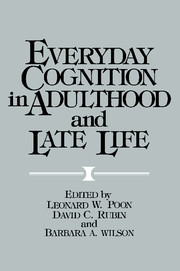Book contents
- Frontmatter
- Contents
- List of contributors
- Preface
- Part I Adult cognitive abilities in the laboratory and in real-life settings: Basic theoretical and methodological issues
- Part IA Systematic approaches to laboratory and real-world research
- Part IB Combining laboratory and real-world research
- 6 The laboratory and ecology: Supplementary sources of data for memory research
- 7 Issues of regularity and control: Confessions of a regularity freak
- 8 Finding the bloody horse
- 9 Some bad and some good reasons for studying memory and cognition in the wild
- Part II Cognition in adulthood and late life: Findings in real-life settings
- Part IIA Everyday cognitive abilities
- Part IIB Concomitant influences
- Part III Cognitive enhancement and aging: Clinical and educational applications
- Part IIIA Issues and perspectives
- Part IIIB Enhancement approaches
- Part IIIC Designing programs for cognitive rehabilitation
- Subject index
- Author index
8 - Finding the bloody horse
Published online by Cambridge University Press: 05 October 2013
- Frontmatter
- Contents
- List of contributors
- Preface
- Part I Adult cognitive abilities in the laboratory and in real-life settings: Basic theoretical and methodological issues
- Part IA Systematic approaches to laboratory and real-world research
- Part IB Combining laboratory and real-world research
- 6 The laboratory and ecology: Supplementary sources of data for memory research
- 7 Issues of regularity and control: Confessions of a regularity freak
- 8 Finding the bloody horse
- 9 Some bad and some good reasons for studying memory and cognition in the wild
- Part II Cognition in adulthood and late life: Findings in real-life settings
- Part IIA Everyday cognitive abilities
- Part IIB Concomitant influences
- Part III Cognitive enhancement and aging: Clinical and educational applications
- Part IIIA Issues and perspectives
- Part IIIB Enhancement approaches
- Part IIIC Designing programs for cognitive rehabilitation
- Subject index
- Author index
Summary
You praise the firm restraint with which they write –
I'm with you there, of course:
They used the snaffle and the curb alright,
But where's the bloody horse?
The quotation comes from the South African poet Roy Campbell and refers to the work of South African novelists of the earlier years of this century. The sentiment is, however, much more widely applicable, and it could, without too much distortion, be applied to the work over the last 50 years of students of memory such as myself. Science needs controlled observation and hence is always open to the risk that excessive control, “the snaffle and the curb,” may stifle the phenomenon that is being observed, “the bloody horse.” Such a criticism is not, of course, novel: “If X is an interesting or socially significant aspect of memory, then psychologists have hardly ever studied X” (Neisser, 1978, p. 4).
The tension between the need for control and the need to preserve the essence of the phenomenon under investigation has been present since the scientific study of memory began 100 years ago, with two investigators both beginning to tackle the question of how human memory could best be studied. In Germany, Ebbinghaus opted for a highly constrained experimental approach in which the phenomena of memory were stripped down to the minimum, with everything rigidly controlled. If it proved difficult to hold something constant, as was the case with meaning, then every effort was made to exclude it from the study.
- Type
- Chapter
- Information
- Everyday Cognition in Adulthood and Late Life , pp. 104 - 115Publisher: Cambridge University PressPrint publication year: 1989
- 5
- Cited by



